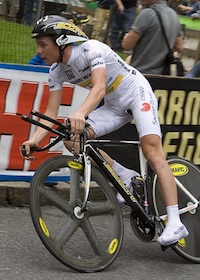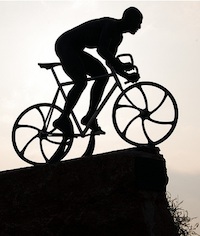“I always said that doping was generalized and you could say even democratic up to the time when they developed a test for EPO, then it became elitist. You needed cutting-edge methods to get around the tests from that point on—methods that often only the big riders and teams could access or afford.
The anniversary of Marco Pantani’s death might seem like a strange moment to talk about the progress cycling has made in the fight against doping. After all, the last man to win both the Tour and the Giro in a single year died from an overdose of one of cycling’s oldest performance enhancers. But the post-transfusion hospitalization of Riccardo Ricco just last week, brings out some important contrasts between conditions in Pantani’s heyday and cycling’s current state of affairs.
Pantani, like most of the best riders of his era, never tested positive. But unlike other big names, he left—or spent less effort covering up—an impressive trail of evidence: a then-legal 54% hematocrit value at the ’94 Giro. A whopping 60% after a crash at Milan-Turin the next year. In 1999, he became the first major post-Festina race ejection, being booted for a high hematocrit on Giro d’Italia’s penultimate stage, while leading the GC by more than five-and-half-minutes.
Most of the writing on the Italian following his death suggests that these values were indicative—or even low—for the blood thicknesses he raced at for most of his career. And yet, for all the insistance on the UCI’s part that the 50% limit was merely a “health test”, Pantani never suffered any physical problems due to his abuse of EPO (other than, one could argue, a crippling, clinical depression that lead directly to his death). The same (minus the depression) goes for Riis, Virenque and host of other trailblazers in the use of blood boosting drugs.
It’s not that EPO abuse is without risk—certainly the mystery heart attacks are well-documented—but for the most part, sudden, doping-induced medical emergencies among active pro cyclists were a rarity between 1994 and 2006. Off the top of my head, only one example comes to mind, and it was apparently unrelated to the blood-boosting drug itself.
With the advent of the EPO test in 2001, many people—Michael Ashenden, for example—think a good number of the pros switched over to blood transfusions. A cynical minority seem to believe—based largely on the statements of Thomas Frei—that EPO tests are ineffective, but the very fact that Ricco had chosen to favor transfusions over injections suggests otherwise. No reason to switch off of a successful doping regimen unless you believe it will no longer be effective.
 Indeed, what happened to Riccardo Ricco last week is an extremely rare occurrence in cycling—at least since the 1960s. He might not be quite as big a rider Simeoni is referring to in his quotation above, but certainly with Ricco’s results before his first suspension—and his fingers-in-the-nose victories since—his bankroll would have been more than sufficient to safely finance better living through chemistry at nearly any point in the past.
Indeed, what happened to Riccardo Ricco last week is an extremely rare occurrence in cycling—at least since the 1960s. He might not be quite as big a rider Simeoni is referring to in his quotation above, but certainly with Ricco’s results before his first suspension—and his fingers-in-the-nose victories since—his bankroll would have been more than sufficient to safely finance better living through chemistry at nearly any point in the past.
This startling difference in short-term outcome—podium vs. hospital bed—between the illicit ventures of Pantani and Ricco speaks volumes as to how things have changed in the interceding decade. But the general reaction to their respective falls from grace is a sharper contrast still. The report from a nascent Cyclingnews.com on Pantani’s ’99 expulsion suggests a general sadness, combined with just a hint of conspiracy theory. The most telling part might be the embarrassing lengths Hein Verbruggen goes to to avoid suggesting doping.
Certainly a contrast to the reactions Ricco received to either of his dope-related suspensions. Granted, Ricco didn’t exactly endear himself to anyone, but the blowback from last week’s medical emergency was hardly sympathetic, hedged, or ambiguous. One can only hope things end up better for Ricco than they did for rider he had always hoped to emulate.

There could be several reasons why someone would choose transfusion over EPO, regardless of thoughts regarding the effectiveness of anti-doping testing for EPO. One primary reason could be cost; transfusions are less expensive and easier to accomplish than purchasing a drug.
It seems like there is still a long way to go, at least with respect to Spain. The fact that the president of Spain is going to bat for Contador is pretty crazy. He wouldn’t be taking the side of an athlete that tested positive for doping if thought that would be an unpopular with the people.
And what about the news that Valverde is training with his old team? What sponsor would allow that if they thought it would be bad publicity? That certainly sends the message that the team is fine with doping. If I was a rider on that team that worried about my reputation, I certainly wouldn’t want Valverde around.
For cycling to truly be clean the culture has to change. It seems that most people have gotten the message but the Spanish just don’t care.
controversies aside, let Pantani missed! grazie Marco!
Julio Delbone (Valinhos, Brazil)
Nicely written! One thing we think is clear, Marco Pantani would have been a star with or without dope. He may not have had the ability in the chrono stages to win the big tours but there’s no doubt about his climbing ability and his amazing drive to come back from repeated misfortunes. You don’t get THAT from dope! THIS is what endears him to Italians and other cycling fans. He’d get injured in crashes (most of them not his fault) like Fausto Coppi but overcome the challenges to compete and win again….and again. We’ve put a tribute to Il Pirata on our blog here https://cycleitalia.blogspot.com/2011/02/marco-pantani.html
One thing we hope for Ricco, PLEASE don’t follow your hero to an early grave, find something else to do with your life in order to take care of your son. Buona fortuna!
7 years after pantani feels lke a great moment for the pope to declare Pantani a saint 🙂
Great post, Cosmo. It’s nice to hear someone point out the selective ambivalence that people express toward different doping cases.
Nice read as usual. A bit rambling but that’s okay.
It seems to me that we can’t know what progress has been made in the fight against doping. I guess the extreme doping has stopped so, from a harm minimisation perspective, things are better.
One thing is for sure, the condemnation for getting caught has ramped way up. If only they would put caffeine on the banned list (for any quantity) then those two caffeine free cycling fans could feel even more self-righteous.
OT: Now that the season has officially started, I’m looking forward to the next HTRWW.
7 years after Patani nothing has changed. I contend in fact that things have gotten worse.
Check this story: Fuyu Li unkown rider for Radioshack tests positive for Clenbuterol in 2010; immediatelly after his B sample comes back positive Johaan the B. sacks him. Absolutely no one cares. The guy’s career is effectively over.
Enter Contador, same facts same amount of clenbuterol. Case is dragged out forever (merci l’uci!), the Spanish federation tells us he’s clean (making a joke of the applicable legal standards) and even though this ludicrous verdict may eventually be overturned by the CAS, Contador can ride in the meantime potentially making a virtual joke of all events he enters…
Can you say “double standard”? This kind of injustice is ongoing and out in the open — it’s just that few here want to discuss Fuyu Li (save for Podium Cafe) and the obvious corruption of the UCI (not to mention the knee-jerk patriotism of every national federation). At least in the 1990’s they felt like they had to cover things up a little….
Forgot the sign the above.
Btw, can we make a “Justice for Fuyu Li” T-shirt — I’d buy that to go with my “Stop Lance” one.
Rather than “justice” for the Chinese guy, I’d like to see Il Pistolero banned for the same length of time as he was. The rules are very clear, they find ANY amount of the banned substance in your A and B sample, you get to find something else to do for a living for two years. It’s great to read about fast-tracking the “plastic molecule in the peepee” test — it’ll be very interesting to read the results of retroactive tests done on samples collected since the EPO tests were proven effective and transfusions were banned. The science/testing folks will need to be very careful on thresholds for this test, making darn sure BS excuses like “I must have eaten the plastic wrapper on the steak” or “It’s because I drink from so many plastic water bottles”, can be dismissed – with no wiggle room from corrupt national federations or the UCI.
Nice Post.
Good Read on Marco, I miss watching him
Hey can you please elt me know concern person’s name who has written the blog and their email id.
Kindly revert